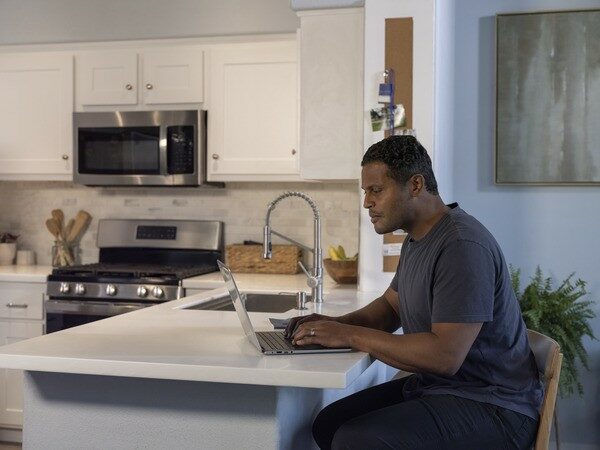
In 2020, many people were forced to turn their kitchens, living rooms, and spare rooms into home offices. Depending on your job type, you may be able to get things done just fine from your home workspace with a few tweaks. But there’s usually room to improve. Here are a few tips on creating a productive, inspiring, and comfortable work-from-home environment.
1. Start with a well-defined area
If you have an additional room in your home for an office, you probably already have a defined space to work. If you don’t have an extra bedroom or bonus room, you’ll need to clear a space to use as your office. This may be in your family room or living room.
You can use furniture creatively to partition off the area and define the workspace. For instance, use bookshelves as small walls, or purchase a room divider so your office space doesn’t blend into another area. This keeps all your supplies in one area, and it also signals to your brain that, when you’re in the space, it’s time to get focused.
2. Pick the right desk
You’ll likely spend most of your time in the office working at a desk, so it needs to be functional and comfortable. You need a tabletop big enough for your laptop or computer, and you need storage solutions. A clutter-free desk encourages productivity, so focus on functionality over aesthetics.
You can add additional storage to your office space, but make sure your desk has enough room for current work files, invoices, incoming and outgoing mail, office supplies and any other items you use on a daily basis. If your office is part of the living room, you may want to choose a workstation armoire that blends in with your current furniture. You can close its doors when the workday is done or when you’re tidying up for company.
3. Opt for ergonomic features
Give your office ergonomic features that improve your health and comfort. One of the most important items you’ll need is a comfortable, supportive chair. Look for adjustable support options to keep your spine aligned and upright while working.
You might also consider a footrest, a supportive mouse pad to protect your wrist or even an adjustable desk that gives you the option to sit or stand.[2]
4. Add the right colors
Colors impact your mood, so it’s important to consider color when you add paint and furniture to your list of home office décor ideas.
What colors should you go with? Anything that’s white or close to it (beige, tan, ivory, light gray) is considered neutral and can be paired with a splash of a vibrant color to liven up an office. Green is a restful, peaceful color that can help you focus, and light yellow represents optimism and cheerfulness.
Try to stay away from bold colors like red, dark purple or bright orange for anything big. When used in abundance, these colors are distracting and can keep you from working efficiently.
5. Add a cozy corner
If you have the space, consider creating a small area that’s warm and inviting. Place a comfy recliner in the corner with a small table, or place a nice bench next to your window. This area isn’t for deadline-crazed days; instead, it’s a comfy spot where you can unwind, enjoy a cup of coffee in between calls or brainstorm new ideas.
6. Avoid cord spaghetti
Electronics might be portable, but you have to plug most in at some point. Most offices are full of cords that can get tangled and messy. Use a power strip hidden by the back of your desk to plug electronics in, or use a cord cable that wraps around several cords to avoid the spaghetti look. Use cord clips to keep loose charging cords accessible without running across your workspace.
7. Embrace warm lighting
You want a well-lit office to keep you alert. If you have natural light in your office, utilize it. Avoid hanging heavy drapes or dark curtains that minimize the light. Add a few lamps to the room, too.
Avoid fluorescent lighting; it generates a ticking sound and gives off harsh light that isn’t conducive to productivity. Opt for daylight bulbs that match the natural sunlight coming in instead.[3]
8. Add a vision board to the wall
Aside from colorful wall art, consider adding a vision board to your wall. On the days you’re struggling to stay productive or are just having a tough day, a vision board helps remind you of your bright future.
To make a vision board, cover a corkboard with paper. Pin pictures, quotes and a list of goals to the board to keep you motivated when you feel a little worn down.
A home office space that’s well-designed and inviting is just one part of the equation. Working from home changes your commute and often the way you live. When your life changes, shouldn’t your insurance change, too? Nationwide has Work From Home Insurance to fit your lifestyle.
[1] “Out of the Office: More Americans Working Remotely, Survey Finds,” NY Times
[2] “Office Ergonomics,” University of North Carolina at Chapel Hill
[3] “How to Create the Perfect Home Office Lighting Setup,” Apartment Therapy



